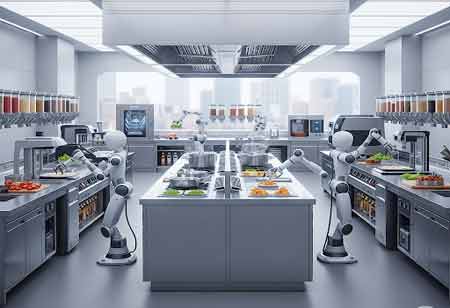Thank you for Subscribing to Food Business Review Weekly Brief
Kitchen 4.0: The Automation Wave Changing How Food is Made
Commercial kitchens increasingly adopt automation technologies to address labor shortage, enhance efficiency, improve food safety, and elevate customer experiences. Innovations like robotics and IoT are pivotal in transforming food service operation.

By
Food Business Review | Friday, May 23, 2025
Stay ahead of the industry with exclusive feature stories on the top companies, expert insights and the latest news delivered straight to your inbox. Subscribe today.

Fremont, CA: The commercial kitchen is transforming profoundly, driven by an accelerating wave of automation technologies. From sophisticated robotics to intelligent management systems, restaurants, dark kitchens, and institutional food service operations embrace innovation to tackle labor shortages, enhance efficiency, ensure consistency, and elevate the customer experience.
The Driving Forces Behind Automation Adoption
Automation in commercial kitchens, a response to labor shortages, rising costs, and the need for consistency and quality, significantly enhances food safety. Reducing the need for a large workforce and high labor costs minimizes human error and increases efficiency and speed of service. It also reduces direct human contact with food, thereby enhancing food safety and hygiene. The data-driven decision-making from connected kitchen equipment and smart management systems provides insights into operational efficiency, ingredient usage, and peak demand periods, enabling informed business decisions that further promote food safety and instill confidence in operations.
Key Commercial Kitchen Automation Technologies
Kitchen automation is a burgeoning field encompassing various technologies designed to automate different aspects of food preparation, cooking, and management. Robotics is now actively operating in commercial kitchens, handling repetitive, high-volume, or hazardous tasks with precision and speed. These include robotic fry cooks, baristas, automated food preparation robots, robotic chefs/cooking arms, delivery robots and drones. The Internet of Things (IoT) connects kitchen equipment, empowering users with real-time monitoring, control, and data exchange capabilities. Connected ovens and combo-ovens can be remotely monitored and controlled, while smart refrigerators and freezers track inventory and temperature. Automated cooking kettles and blenders ensure consistent results, while automated dishwashers and grease management systems improve kitchen safety and cleanliness. Intelligent management systems (AI & software solutions) are optimizing kitchen operations from order to inventory. These systems include kitchen display systems, automated inventory management, point-of-sale systems, AI-powered menu planning and nutrition tracking, and predictive analytics for demand forecasting. Front-of-house automation, such as self-ordering kiosks and mobile ordering apps, streamlines ordering and payment processes, allowing kitchen staff to focus on food preparation.
Benefits of Commercial Kitchen Automation
Implementing automation technologies in the food industry can greatly enhance food safety, among other benefits. These include increased efficiency, consistent food quality, cost reductions, improved employee experience, scalability, and data-driven insights. Automated processes eliminate variability, reduce labor costs, and optimize energy consumption, while minimizing human contact and temperature control.
The future of commercial kitchens will likely involve a symbiotic relationship between humans and machines, with automation handling repetitive tasks and human chefs focusing on creativity and innovation. Expect more 'robot-assisted' kitchens, hyper-personalization, miniaturization, modularity, and enhanced sustainability. This sustainability focus will be a key driver, reducing energy consumption, water usage, and food waste, and contributing to environmentally friendly operations.
Commercial kitchen automation is not just a trend; it's a fundamental shift in how food is prepared and served. By embracing these innovative technologies, the food service industry can overcome pressing challenges, unlock new levels of efficiency, and deliver unparalleled experiences to a discerning clientele.






